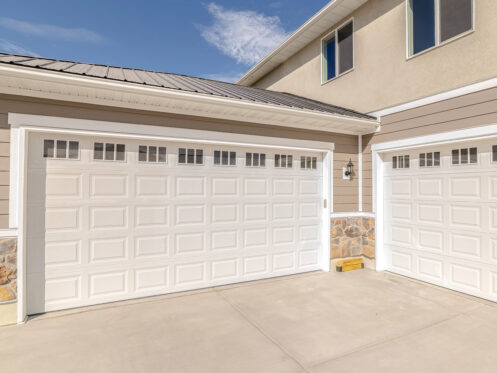Emergency preparedness is about being ready for whatever life throws your way. And even though you might not give much thought to it, your garage door plays an important role in emergency preparedness. It’s not just about parking your car; it’s also a key part of your home’s security and safety. Checking its functionality is an important aspect of being ready for emergencies.
Test Emergency Release Mechanism
The emergency release mechanism on a garage door is a safety feature designed to manually open the door during power outages or malfunctions. Typically, it consists of a cord or handle attached to a bypass mechanism that disengages the automatic opener, allowing the door to open manually. Some configurations place it near the door’s motor unit or integrate it into the garage door opener.
Regularly testing the emergency release mechanism is essential to ensure it functions properly during emergencies. To test it you can pull the cord or handle downward until you hear a click, indicating that the mechanism has disengaged. Then, attempt to manually lift the garage door. If it opens smoothly and without resistance, the emergency release works correctly. You should test this feature periodically, such as monthly or bi-annually, to maintain its functionality and ensure its readiness for emergencies. If the mechanism releases but the door is heavier than it should be, that may indicate an issue with your garage door opener’s spring, which warrants immediate attention.
Test Battery Backup Systems
Battery backup systems for garage doors ensure continued operation during power outages. Most backup systems have a rechargeable battery unit connected to the garage door opener. Some feature a separate battery box that you can mount nearby. If there is a power outage, the battery backup system automatically kicks in, allowing the garage door opener to function normally. This enables homeowners to access their garages and vehicles, even during emergencies when electricity is unavailable.
All you have to do to test the system is flip off the circuit breaker that powers the garage door opener or unhook the door’s power supply. Then, activate the garage door opener using the remote control or wall-mounted button. If the door operates smoothly, the battery backup system functions as it should. Many experts recommend testing backup systems once every few months.
Check Weatherproofing and Insulation
Weatherproofing seals the gaps between the door and the frame, preventing drafts, moisture, and outdoor elements from entering your Louisville garage. This helps maintain a consistent indoor temperature and protects belongings stored inside. On the other hand, insulation regulates temperature and reduces heat transfer, especially in extreme weather conditions. It keeps the garage space warmer in winter and cooler in summer.
You should periodically inspect the weatherstripping for signs of wear, damage, or deterioration and replace it if necessary. Similarly, assess the insulation materials for gaps or compression and add additional insulation as needed. A well-sealed and insulated garage door reduces heat loss or gain during power outages and harsh weather. You can use this to make your home more cozy and safe for you and your possessions.
Secure Your Garage Door Openers
Flashlights, batteries, first aid kits, bottled water, non-perishable food, blankets, wrenches, screwdrivers, fire extinguishers, and portable generators are common emergency supplies that people keep in garages. In the case of an emergency, having a garage door opener on hand is imperative, as it allows for easy and fast access to the garage. But there’s a security danger in keeping the opener for the garage door visible and out in the open; it makes it much easier for intruders to get into the garage and maybe even inside the house.
You should have a strategy to keep your garage door opener secure. This will help keep unauthorized people out and help make your property safer. One way to do this is to put keypads and remote controls in a safe place while they are not in use, such as a cupboard or drawer, inside the house. To add another degree of protection, you may want to get a smart garage door opener or keypad entry system that needs a PIN code or a mobile app to open it.
Maintain Proper Lubrication
Lubrication reduces friction on moving parts, including the garage’s hinges, rollers, and tracks. To check and add lubrication to your garage door, inspect all moving parts for signs of wear, rust, and debris buildup. Clean up any dirt or debris using a soft brush or cloth, and remove any rust using a wire brush or sandpaper. Once clean, apply a silicone-based or lithium-based lubricant to the hinges, rollers, tracks, and springs. Use a spray or a small amount of lubricant on a rag to apply it.
Make sure you apply lubricant sparingly and avoid over-application, as excess lubricant can attract dirt and debris, causing buildup and potential issues with the garage door’s operation. Regular lubrication maintenance, typically performed every six months to a year, keeps your garage door ready to respond effectively in emergencies.
Emergency Repair Kit Essentials
Emergency repair kit essentials for garage doors typically include tools such as wrenches, screwdrivers, pliers, locking pliers, and a hammer. These tools are vital for addressing common issues like loose bolts or screws, misaligned tracks, and damaged panels. Make sure to familiarize yourself with the contents of your emergency repair kit and ensure it’s easily accessible in case of emergencies.
Always follow the manufacturer’s directions and take all necessary safety measures when using items from your emergency repair kit. To avoid further damage, check the alignment and tightness of the nuts and screws before proceeding. Similarly, when replacing rollers or hinges, follow the correct installation procedure to ensure smooth and reliable operation. Consider hanging the repair kit on a hook or placing it in a designated toolbox that you mount on a wall near the garage door for easy access.
Training and Communication
Ensuring that everyone in the home knows what to do in an emergency requires establishing ground rules for communicating. This may include designating a specific meeting point outside the home in case of evacuation and ensuring everyone knows how to contact emergency services or neighbors for assistance. It’s equally important to communicate any changes or updates to emergency procedures to ensure everyone remains prepared and informed.
Keep a Fire Extinguisher Nearby
Electrical failure is the most common reason for garage fires, often involving lights, outlets, and mechanisms for opening garage doors. It’s important to have a fire extinguisher in the garage to address any potential fire emergencies. Regularly inspecting electrical components and promptly addressing any issues can also help mitigate the risk of electrical failures and subsequent fires.
Schedule Yearly Inspections
Annual inspections by skilled technicians are necessary to keep your home’s garage door working properly. These experts possess the expertise to uncover potential issues that might escape notice otherwise. With their help, you can rest assured that your garage door remains in top-notch condition, ready to withstand any unexpected challenges.
You can stay on top of emergency preparedness for your home with our garage door repairs, replacements, and maintenance service. Give Lewis Door Service a call now to schedule a garage inspection for your home in Louisville, KY.

